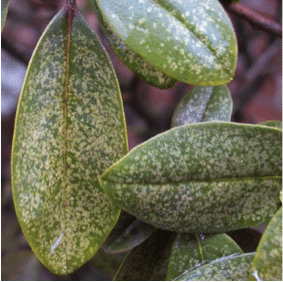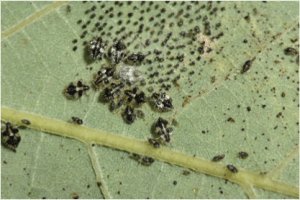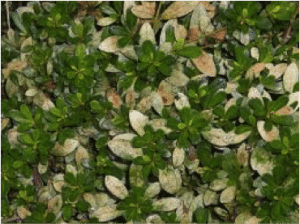Lace Bug Damage

We’re seeing heavy infestations of Lace Bug populations (not to be confused with “lace wings” which are beneficial predators) on Azaleas, Rhododendrons, Andromeda, Cotoneaster, and other shrubs and trees on numerous properties that don’t have Integrated Pest Management programs in place.
There are a variety of lace bugs, each with a preference for particular plant varieties. The adult and nymph forms both have piercing, sucking mouthparts and feed on the undersides of the plant’s leaves.
Heavy infestations weaken plant health and vigor, leaving them vulnerable to other insect damage, disease, and environmental stress. Regular monitoring by our Plant Health Care diagnosticians usually detects lace bug populations before damage reaches the level of yellowish to white stippling on the topsides of leaves. Left untreated, plants decline and can eventually die.
Lifecycle
 In mid-May, eggs that have been allowed to overwinter on the underside of leaves begin hatching. Lace bugs can have as many as 4 generations or more in a year depending on weather conditions. Left undetected, populations can quickly reach levels causing economic and aesthetic damage.
In mid-May, eggs that have been allowed to overwinter on the underside of leaves begin hatching. Lace bugs can have as many as 4 generations or more in a year depending on weather conditions. Left undetected, populations can quickly reach levels causing economic and aesthetic damage.
How to Control Lace Bugs
 In early spring, our technicians begin inspecting the undersides of leaves of susceptible plants for evidence of overwintering adults, eggs and newly hatched nymphs. Early control in the spring puts a damper on the reproductive pipeline during the season, and fall control limits overwintering populations for the subsequent year, keeping populations at tolerable levels.
In early spring, our technicians begin inspecting the undersides of leaves of susceptible plants for evidence of overwintering adults, eggs and newly hatched nymphs. Early control in the spring puts a damper on the reproductive pipeline during the season, and fall control limits overwintering populations for the subsequent year, keeping populations at tolerable levels.
Minor infestations can be effectively knocked-back and kept in check with insecticidal soaps, neem oil, and horticultural oils which preserve beneficial predators such as green lacewings, earwigs, spiders, minute pirate bugs and assassin bugs.
It’s very important to note that sprays must adequately cover the undersides of the leaves to be effective. Regular monitoring will catch any re-infestations and determine if additional treatments are necessary.
Featured image courtesy of Jim Baker, North Carolina State University, Bugwood.org
GET THE LATEST NEWS
Subscribe to the Organic Plant Care Newsletter and get timely and helpful tips and updates monthly.
There's no spam - we promise!





